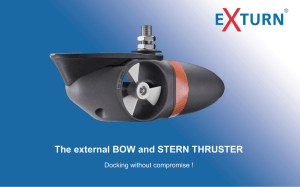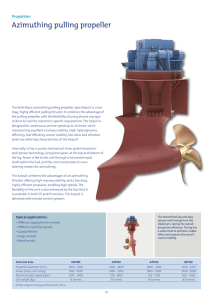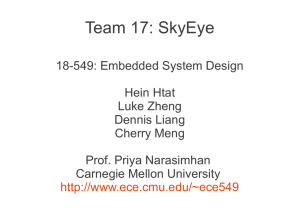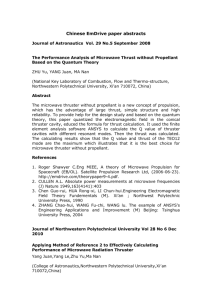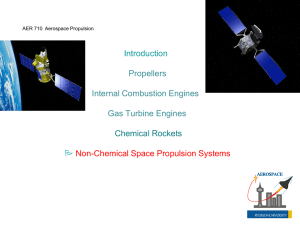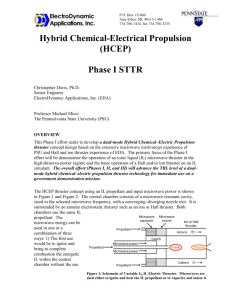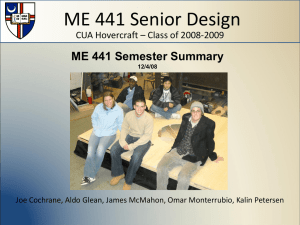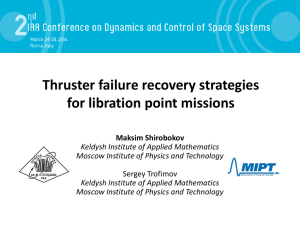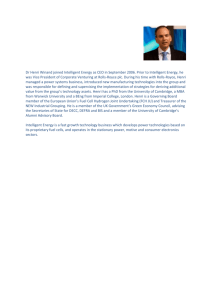Permanent Magnet Technology Permanent Magnet - Rolls
advertisement
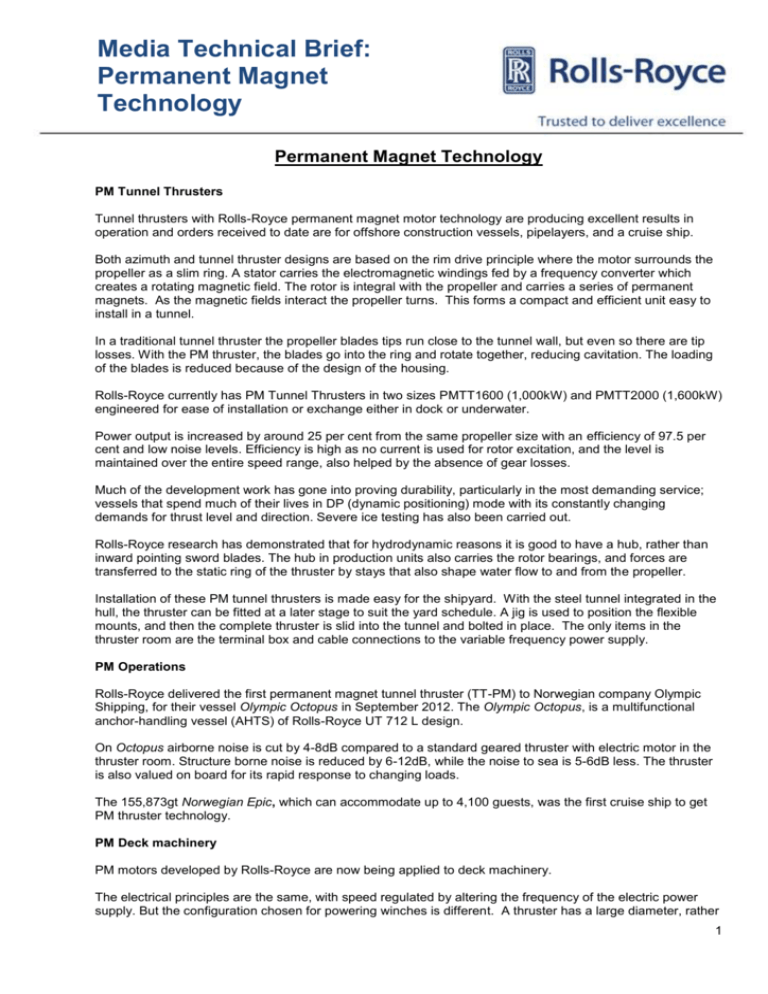
Media Technical Brief: Permanent Magnet Technology Permanent Magnet Technology PM Tunnel Thrusters Tunnel thrusters with Rolls-Royce permanent magnet motor technology are producing excellent results in operation and orders received to date are for offshore construction vessels, pipelayers, and a cruise ship. Both azimuth and tunnel thruster designs are based on the rim drive principle where the motor surrounds the propeller as a slim ring. A stator carries the electromagnetic windings fed by a frequency converter which creates a rotating magnetic field. The rotor is integral with the propeller and carries a series of permanent magnets. As the magnetic fields interact the propeller turns. This forms a compact and efficient unit easy to install in a tunnel. In a traditional tunnel thruster the propeller blades tips run close to the tunnel wall, but even so there are tip losses. With the PM thruster, the blades go into the ring and rotate together, reducing cavitation. The loading of the blades is reduced because of the design of the housing. Rolls-Royce currently has PM Tunnel Thrusters in two sizes PMTT1600 (1,000kW) and PMTT2000 (1,600kW) engineered for ease of installation or exchange either in dock or underwater. Power output is increased by around 25 per cent from the same propeller size with an efficiency of 97.5 per cent and low noise levels. Efficiency is high as no current is used for rotor excitation, and the level is maintained over the entire speed range, also helped by the absence of gear losses. Much of the development work has gone into proving durability, particularly in the most demanding service; vessels that spend much of their lives in DP (dynamic positioning) mode with its constantly changing demands for thrust level and direction. Severe ice testing has also been carried out. Rolls-Royce research has demonstrated that for hydrodynamic reasons it is good to have a hub, rather than inward pointing sword blades. The hub in production units also carries the rotor bearings, and forces are transferred to the static ring of the thruster by stays that also shape water flow to and from the propeller. Installation of these PM tunnel thrusters is made easy for the shipyard. With the steel tunnel integrated in the hull, the thruster can be fitted at a later stage to suit the yard schedule. A jig is used to position the flexible mounts, and then the complete thruster is slid into the tunnel and bolted in place. The only items in the thruster room are the terminal box and cable connections to the variable frequency power supply. PM Operations Rolls-Royce delivered the first permanent magnet tunnel thruster (TT-PM) to Norwegian company Olympic Shipping, for their vessel Olympic Octopus in September 2012. The Olympic Octopus, is a multifunctional anchor-handling vessel (AHTS) of Rolls-Royce UT 712 L design. On Octopus airborne noise is cut by 4-8dB compared to a standard geared thruster with electric motor in the thruster room. Structure borne noise is reduced by 6-12dB, while the noise to sea is 5-6dB less. The thruster is also valued on board for its rapid response to changing loads. The 155,873gt Norwegian Epic, which can accommodate up to 4,100 guests, was the first cruise ship to get PM thruster technology. PM Deck machinery PM motors developed by Rolls-Royce are now being applied to deck machinery. The electrical principles are the same, with speed regulated by altering the frequency of the electric power supply. But the configuration chosen for powering winches is different. A thruster has a large diameter, rather 1 thin and narrow motor driving the propeller on its periphery. The deck machinery motor has a smaller diameter and is longer for a given power to suit the speed requirements. It drives the winch by a central shaft and high torque allows a small gear ratio, improving the dynamic response of the winch. The characteristics of these PM motors are particularly suited to applications that combine a need for high torque at low speed, sensitive control and rapid changes in pull and speed. Anchorhandling/towing winches for offshore vessels, escort winches for tugs, and trawl winches for fishing vessels are typical applications. Low pressure hydraulic winches from Rolls-Royce have for many years been market leaders when it comes to delivering this type of performance, and the new PM drive system will do the same for owners preferring an electric solution. For AHT winches, owners will be able to chose the Rolls-Royce drive system that best suits their preference and operating modes. The four systems are the standard LP hydraulic; LP hydraulic with the new E26 computer controlled valve system for extra sensitive control; a hybrid system in which the average loads are covered by variable frequency asynchronous electric motor with a supplementary hydraulic drive that handles quickly changing loads; and the new PM electric drive. PM motors have undergone extensive factory development testing, independent verification of IP standard of waterproofing and are now Class approved. The first installation in commercial service will be a trawl winch on a fishing vessel of Rolls-Royce design currently under construction for Prestfjord. PM Azimuth Thruster Rolls-Royce launched a new azimuth thruster powered by permanent magnet (PM) technology at NorShipping in Oslo in June 2015. The launch followed a programme of sea trials place on board the RV Gunnerus, the Norwegian University of Science and Technology’s (NTNU) research ship, based in Trondheim. On trial a pair of thrusters demonstrated efficiency savings of 7-13% depending on ship speed, and in comparison to azimuth thrusters powered by a conventional diesel-electric system. Each PM azimuth thruster comprises three main assemblies – the PM motor/propeller/nozzle underwater unit, the hull mounting system which includes the azimuth bearing and duplicate frequency controlled electric steering gear, and the inboard power unit which feeds electric power to the thruster. The permanent magnet motor consists of two main parts – a stator that carries a number of electrical coil windings, and a rotor fitted with a number of very strong permanent magnets. A rotating magnetic field is created by the stator which interacts with the fields of the permanent magnets on the rotor, which generates force to drag the rotor around, providing the mechanical power. The PM azimuth thruster will remain on sea trial aboard the research vessel Gunnerus throughout 2015. For further information including pictures, please contact: Craig Taylor Head of Communications – Marine Rolls-Royce m: +44 (0) 7807 969 426 e: craig.taylor2@rolls-royce.com 2
